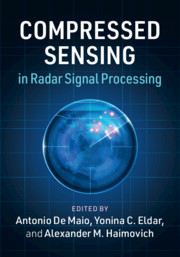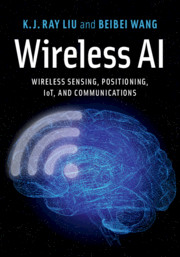Refine listing
Actions for selected content:
9096 results in Communications, Signal Processing and Information Theory
18 - Waveforming
- from Part IV - 5G Communications and Beyond
-
- Book:
- Wireless AI
- Published online:
- 27 September 2019
- Print publication:
- 03 October 2019, pp 451-485
-
- Chapter
- Export citation
Index
-
- Book:
- Wireless AI
- Published online:
- 27 September 2019
- Print publication:
- 03 October 2019, pp 605-606
-
- Chapter
- Export citation
19 - Spatial Focusing Effect for Networking
- from Part IV - 5G Communications and Beyond
-
- Book:
- Wireless AI
- Published online:
- 27 September 2019
- Print publication:
- 03 October 2019, pp 486-516
-
- Chapter
- Export citation
6 - Wireless Events Detection
- from Part II - Wireless Sensing and Analytics
-
- Book:
- Wireless AI
- Published online:
- 27 September 2019
- Print publication:
- 03 October 2019, pp 117-142
-
- Chapter
- Export citation
17 - Time-Reversal Massive Multipath Effect
- from Part IV - 5G Communications and Beyond
-
- Book:
- Wireless AI
- Published online:
- 27 September 2019
- Print publication:
- 03 October 2019, pp 423-450
-
- Chapter
- Export citation
11 - Device-Free Speed Estimation
- from Part II - Wireless Sensing and Analytics
-
- Book:
- Wireless AI
- Published online:
- 27 September 2019
- Print publication:
- 03 October 2019, pp 239-270
-
- Chapter
- Export citation
9 - Vital Signs Estimation and Detection
- from Part II - Wireless Sensing and Analytics
-
- Book:
- Wireless AI
- Published online:
- 27 September 2019
- Print publication:
- 03 October 2019, pp 199-227
-
- Chapter
- Export citation
20 - Tunneling Effect for Cloud Radio Access Network
- from Part IV - 5G Communications and Beyond
-
- Book:
- Wireless AI
- Published online:
- 27 September 2019
- Print publication:
- 03 October 2019, pp 517-546
-
- Chapter
- Export citation
21 - Time Reversal for IoT
- from Part V - IoT Connections
-
- Book:
- Wireless AI
- Published online:
- 27 September 2019
- Print publication:
- 03 October 2019, pp 549-582
-
- Chapter
- Export citation
10 - Wireless Motion Detection
- from Part II - Wireless Sensing and Analytics
-
- Book:
- Wireless AI
- Published online:
- 27 September 2019
- Print publication:
- 03 October 2019, pp 228-238
-
- Chapter
- Export citation
1 - Principles of Time Reversal and Effective Bandwidth
-
- Book:
- Wireless AI
- Published online:
- 27 September 2019
- Print publication:
- 03 October 2019, pp 1-16
-
- Chapter
- Export citation
Frontmatter
-
- Book:
- Wireless AI
- Published online:
- 27 September 2019
- Print publication:
- 03 October 2019, pp i-iv
-
- Chapter
- Export citation
3 - Multiantenna Approach
- from Part I - Indoor Locationing and Tracking
-
- Book:
- Wireless AI
- Published online:
- 27 September 2019
- Print publication:
- 03 October 2019, pp 39-65
-
- Chapter
- Export citation
15 - Time-Reversal Division Multiple Access
- from Part IV - 5G Communications and Beyond
-
- Book:
- Wireless AI
- Published online:
- 27 September 2019
- Print publication:
- 03 October 2019, pp 365-392
-
- Chapter
- Export citation

Compressed Sensing in Radar Signal Processing
-
- Published online:
- 30 September 2019
- Print publication:
- 17 October 2019

Wireless AI
- Wireless Sensing, Positioning, IoT, and Communications
-
- Published online:
- 27 September 2019
- Print publication:
- 03 October 2019
References
-
- Book:
- Game Theory for Next Generation Wireless and Communication Networks
- Published online:
- 13 June 2019
- Print publication:
- 27 June 2019, pp 459-493
-
- Chapter
- Export citation
12 - Applications of Game Theory in Context-Aware Networks and Mobile Services
- from Part II - Applications
-
- Book:
- Game Theory for Next Generation Wireless and Communication Networks
- Published online:
- 13 June 2019
- Print publication:
- 27 June 2019, pp 315-346
-
- Chapter
- Export citation
Frontmatter
-
- Book:
- Game Theory for Next Generation Wireless and Communication Networks
- Published online:
- 13 June 2019
- Print publication:
- 27 June 2019, pp iii-vi
-
- Chapter
- Export citation
13 - Applications of Game Theory for Green Communication Networks
- from Part II - Applications
-
- Book:
- Game Theory for Next Generation Wireless and Communication Networks
- Published online:
- 13 June 2019
- Print publication:
- 27 June 2019, pp 347-376
-
- Chapter
- Export citation
